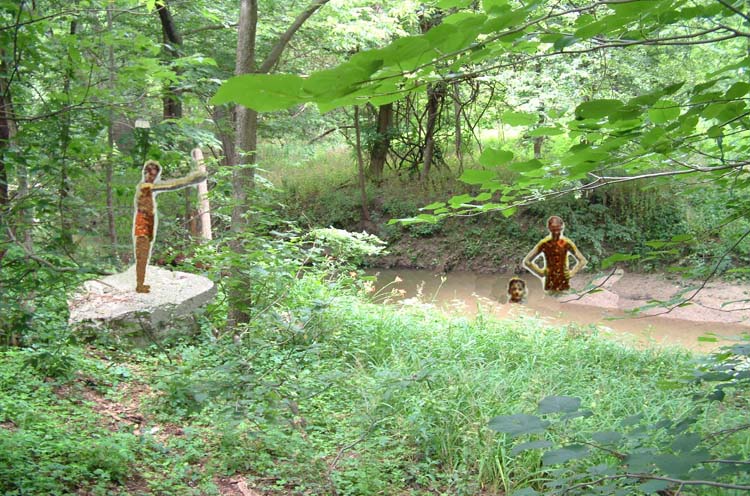
A
scene reminiscent of an “old swimming hole,” one of many used by Iowa City
youngsters for decades,
is recreated using a current photo of Ralston Creek east of the Woodlawn
neighborhood with boys digitally
added from a century-old postcard image. Current photo and collage by Bob
Hibbs.
|
By
Bob Hibbs Ralston
Creek was too dirty for swimming a century ago; but, not polluted by chemicals
which began in earnest during the 1940s. None-the-less, during the era before
swimming pools, Ralston Creek and the Iowa River were summer havens for
youngsters – particularly boys – for more than a century beginning in the
1840s. Perhaps
the most popular swimmin’ hole was the Iowa River just below City Park after
construction of the 1908 Park Road bridge, a steel high truss stretching up
more than 30 feet above the water. “Bridge diving” was a dare-devil
undertaking accomplished by many with no records of who was hurt; but,
apparently, no one died. A
close second, particularly during the decade of the 1920s, was the Iowa River
in the bend near the southern end of Rocky Shore Drive at a place commonly
known a century ago as Black Springs beach. The Crandic pocket park is now
located along that stretch of the river. The
Woodlawn swimming hole is called to mind by an article written by John
Springer and preserved in the 1924 yearbook of the Old Settlers’ Association
of Johnson County. Springer arrived in Iowa City in 1857 as a child with his
parents. Their
first nights in Iowa City were spent in local hotels, first one on South
Clinton where they slept on the floor, then in the American House –
previously National Hotel and later Swan’s Hotel operated by Iowa City
founder Chauncey Swan and his wife, Dolly, on a site now serving Gilmore Hall
just north of Pentacrest. However,
Springer writes: “Living at an Iowa City hotel in 1857 was quite too
expensive for my parents, and a small piece of land was purchased on the east
side of the city; indeed it is now (1924) the eastern boundary of East Iowa
City and a little house built thereon.” East
Iowa City was an unincorporated community stretching from Seventh Avenue east
to First Avenue, a neighborhood established around an 1899 W.F. Main Co.
jewelry factory located on the north side of Friendship Street between Third
and Fifth, a site now owned by Carl Chadek. The
three-story factory building there burned in 1937. Of
swimming at Woodlawn, Springer reports: “Here town and country boys,
(unclothed) in the one universal uniform, fraternized and fought without
interruption save as comrades cheered and encouraged.” This
is at a spot just below the confluence of the north and east branches of
Ralston Creek, about three blocks outside (east of) the original square mile
located within the 1839 city limits, which ended at the west edge of then
non-existing Summit Street, and a block east of North Governor Street. Another
dare-devil swimming spot was in Iowa City’s “north-ender” neighborhood
– the area north of Brown Street and Oakland Cemetery. There existed near
the crest of the North Dubuque Street hill for more than a half century a
large elevated storage tank, part of the municipal water system, which
originally was a private operation. An
oft-repeated boyhood initiation ceremony required many a young lad to climb
the 60 feet or more to the top of the tank, and then lower himself into the
water for a swim. Not an undertaking for the faint hearted; but, there is no
record indicating anyone was hurt or drowning before the tank was demolished a
quarter century ago. Kids
may have been tough in those years, but one sometimes wonders how any of us
had forbearers survive to adulthood. Next
Saturday:
The telephone girls of 1911. Bob
Hibbs collects local postcards and other historic ephemera and researches
history related to them. |